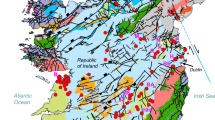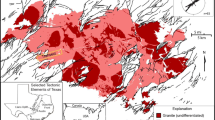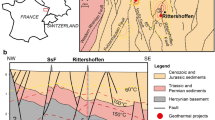Abstract
Groundwater movement and availability in crystalline and metamorphosed rocks is dominated by the secondary porosity generated through fracturing. The distributions of fractures and fracture zones determine permeable pathways and the productivity of these rocks. Controls on how these distributions vary with depth in the shallow subsurface (<300 m) and their resulting influence on groundwater flow is not well understood. The results of a subsurface study in the Nashoba and Avalon terranes of eastern Massachusetts (USA), which is a region experiencing expanded use of the fractured bedrock as a potable-supply aquifer, are presented. The study logged the distribution of fractures in 17 boreholes, identified flowing fractures, and hydraulically characterized the rock mass intersecting the boreholes. Of all fractures encountered, 2.5% are hydraulically active. Boreholes show decreasing fracture frequency up to 300 m depth, with hydraulically active fractures showing a similar trend; this restricts topographically driven flow. Borehole temperature profiles corroborate this, with minimal hydrologically altered flow observed in the profiles below 100 m. Results from this study suggest that active flow systems in these geologic settings are shallow and that fracture permeability outside of the influence of large-scale structures will follow a decreasing trend with depth.
Résumé
Le mouvement de l’eau souterraine et sa disponibilité dans les roches cristallines et métamorphiques sont conditionnés par la porosité secondaire générée par la fracturation. La distribution des fractures et des zones de fractures détermine les lignes de courant et la productivité de ces roches. Les facteurs contrôlant la variation des distributions avec la profondeur dans les aquifères peu profonds (<300 m) et l’influence de ces facteurs sur les flux souterrains ne sont pas bien compris. Les résultats de l’étude de subsurface des terranes de Nashoba et Avalon à l’Est du Massachusetts (USA) sont présentés. Cette région utilise largement le sous-sol rocheux fracturé comme source d’eau potable. L’étude a cartographié la distribution des fractures dans 17 forages, identifié les fractures ouvertes et fourni les caractéristiques hydrauliques du massif traversé par les forages. 2.5% des fractures recoupées sont en charge. Les forages montrent une densité de fracturation décroissante jusqu’à 300 m de profondeur, les fractures en charge suivant une tendance similaire, ce qui restreint la distribution spatiale du flux. Ceci est confirmé par des diagraphies thermiques, avec une perturbation minimale du flux observée à plus de 100 m de profondeur. Les résultats de l’étude suggèrent que dans ce contexte géologique les débits sont peu profonds et que, hors influence de structures à grande échelle, la perméabilité de fracture tend à décroître avec la profondeur.
Resumen
El movimiento y disponibilidad de agua subterránea en rocas cristalinas y metamórficas está dominado por la porosidad secundaria generada a través de la fracturación. La distribución de las fracturas y zonas de fracturas determinan trayectorias permeables y la productividad de estas rocas. Los controles sobre como estas distribuciones varían con la profundidad en el subsuelo somero (<300 m) y su influencia resultante sobre el flujo de las aguas subterráneas no están bien entendidos. Se presentan los resultados de un estudio subsuperficial en terrenos de Nashoba y Avalon en el este de Massachusetts (USA), que es una región que está experimentando un uso expandido del basamento fracturado como un acuífero abastecedor de agua potable. El estudio registró la distribución de fracturas en 17 pozos, identificó fracturas de flujo, y caracterizó hidráulicamente la masa de rocas que intersectan las perforaciones. De todas las fracturas encontradas, 2.5% son hidráulicamente activas. Los pozos muestran una frecuencia de fractura decreciente hasta 300 m de profundidad, con fracturas hidráulicamente activas que muestran una tendencia similar, esto restringe topográficamente el flujo que conducen. Los perfiles de temperatura de los pozos corroboran esto, y se observa un flujo mínimamente alterado desde un punto de vista hidrológico en los perfiles debajo de los 100 m. Los resultados de este estudio sugieren que los sistemas de flujos activos en estas configuraciones geológicas son someros y que la permeabilidad de fractura está fuera de la influencia de las estructuras de gran escala, y sigue una tendencia decreciente con la profundidad.
摘要
结晶岩和变质岩地区地下水的运动和赋存受断裂造成的次生空间控制。裂隙和断裂带的分布决定了其渗透路径和出水能力。裂隙分布在地表以下浅部 (<300 m) 随深度变化的控制因素及其对地下水流动的影响尚不清楚。本文对美国马萨诸塞州东部Nashoba和Avalon岩层进行了现场测量研究, 这些含水层正在被开采用作供水。研究确定了17个钻孔中裂隙的分布和导水性, 及其水力性质。钻遇的所有裂隙中有2.5% 是导水的。向下至300 m深度, 钻孔中裂隙频率呈减小趋势。钻孔温度测量与此一致, 在100 m深度水文扰动很小。结果表明, 这些地质背景下活跃的水流系统存在于浅部。在大规模断裂带外, 裂隙渗透性一般随深度增加而变差。
Resumo
O movimento e a disponibilidade de água subterrânea em rochas cristalinas e metamórficas é dominado pela porosidade secundária gerada pela fracturação. A distribuição das fracturas e das zonas fracturadas determinam os percursos permeáveis e a produtividade destas rochas. O controlo sobre como estas distribuições variam com a profundidade na sub-superfície (<300 m) e a influência que exercem no fluxo de água subterrânea não é ainda bem compreendido. São apresentados os resultados de um estudo da sub-superfície nas áreas de Nashoba e Avalon, no este de Massachusetts (EUA), uma região onde o uso dos aquíferos fracturados do bed-rock tem vindo a expandir-se, como fonte de água potável para abastecimento. O estudo teve acesso à distribuição de fracturas em 17 sondagens, identificando fracturas com fluxo, e caracterizando hidraulicamente o maciço rochoso intersectado pelas sondagens. De todas as fracturas encontradas, 2.5% são hidraulicamente activas. As sondagens mostram um decréscimo da frequência de fracturas até aos 300 m de profundidade, com as fracturas activas do ponto de vista hidráulico a mostrarem uma tendência similar; esta situação restringe o fluxo condicionado pela topografia. Os perfis de temperatura obtidos nas sondagens corroboram esta situação, com fluxos com alteração hidráulica mínima observados nos perfis abaixo dos 100 m. Os resultados deste estudo sugerem que os sistemas activos de fluxo nestes ambientes geológicos são encontrados a baixa profundidade e que a permeabilidade das fracturas, fora da influência das estruturas de grande escala, seguirá uma tendência decrescente com a profundidade.












Similar content being viewed by others
References
Anderson M (2005) Heat as a ground water tracer. Ground Water 43(6):951–968
Bandis S, Lumsden A, Barton N (1983) Fundamentals of rock joint deformation. Int J Rock Mech Min Sci Geomech Abstr 20(6):249–268
Barton C (1996) Characterizing bed rock fractures in outcrop for ground-water hydrology studies: an example from Mirror Lake, Grafton County, New Hampshire. In: Morganwalp D, Aronson D (eds) U.S. Geological Survey Toxic Substances Hydrology Program-Proceedings of the technical meeting, Colorado Springs, Colo. US Geol Surv Water Resour Invest Rep 94-4015
Batu V (1999) Aquifer hydraulics: a comprehensive guide to hydrogeologic data analysis. Wiley, New York
Bell K, Alvord D (1976) Pre-Silurian stratigraphy of northeastern Massachusetts, Memoir 148, Geological Society of America, Boulder, CO
Brown S, Scholz C (1986) Closure of rock joints. J Geophys Res Solid Earth 91(B5):4949–4948
Caine J, Tomusiak S (2003) Brittle structures and their role in controlling porosity and permeability in a complex Precambrian crystalline-rock aquifer system in the Colorado Rocky Mountain Front Range. Geol Soc Am Bull 115(11):1410–1424
Caine J, Evans J, Forster C (1996) Fault zone architecture and permeability structure. Geology 24:1025–1028
Castle R, Dixon J, Grew E, Griscom A, Zeitz I (1976) Structural dislocations in Eastern Massachusetts, US Geol Surv Bull 1410
Davis S, Turk L (1964) Optimum depth of wells in crystalline rock. Ground Water 2:6–11
Evans KF, Moriya H, Niitsuma H, Jones RH, Phillips WS, Genter A, Sausse J, Jung R, Baria R (2005) Microseismicity and permeability enhancement of hydrogeologic structures during massive fluid injections into granite at 3 km depth at the Soultz HDR site. Geophys J Int 160:388–412
Gillespie PA, Howard C, Walsh LL, Watterson L (1993) Measurement and characterisation of spatial distributions of fractures. Tectonophysics 226:113–141
Gillespie PA, Walsh JJ, Watterson J, Bonson CG, Manzocchi T (2001) Scaling relationships of joint and vein arrays from The Burren, Co. Clare, Ireland. J Struct Geol 23:183–201
Goldsmith R (1991) Stratigraphy of the Nashoba zone, Eastern Massachusetts: an enigmatic terrane. US Geol Surv Prof Pap 1366-E-J
Hatch N (ed) (1991) The bedrock map of Massachusetts, US Geol Surv Prof Pap 1366A-J
Hillis R (1987) The influence of fracture stiffness and the in situ stress field on the closure of natural fractures. Petrol Geosc 4(1):57–65
Hsieh P (1996) An overview of field investigations of fluid flow in fractured crystalline rocks on the scale of hundreds of meters. In: Stevens P, Nicholson T (eds) Joint U.S. Geological Survey, Nuclear Regulatory Commission Workshop on Research Related to Low-Level Radioactive Waste Disposal, May 4–6, 1993. US Geol Surv Sci Invest Rep 95-4015
Hsieh P, Shapiro A (1996) Hydraulic characteristics of fractured bedrock under lying the FSE well field at the Mirror Lake site, Grafton County, New Hampshire. In: Morganwalp D, Aronson D (eds) U.S. Geological Survey Toxic Substances Hydrology Program: proceedings of the technical meeting, Colorado Springs, Colo. US Geol Surv Sci Invest Rep 94-4015, pp 127–130
Johnson C, Dunstan A (1998) Lithology and fracture characterization from drilling investigations in the Mirror Lake area from 1979 through 1995 in Grafton County New Hampshire. US Geol Surv Water Resour Invest Rep 98-4183
Johnson C, Williams J (2003) Hydraulic logging methods: a summary and field demonstration in Conyers, Rockdale County, Georgia. In: Williams L (ed) Methods used to assess the occurrence and availability of ground water in fractured-crystalline bedrock: an excursion into areas of Lithonia Gneiss in eastern metropolitan Atlanta, Georgia, vol 23. Georgia Geologic Survey, Atlanta, GA, pp 40-47
Legrand H (1954) Geology and ground water in the Statesville area, North Carolina. Bulletin, North Carolina Division of Mineral Resources, Raleigh, NC
Legrand H (1967) Ground water of the Piedmont and Blue Ridge provinces in the southeastern states. US Geol Surv Circ 528
Lyford FP, Carlson CS, Hansen BP (2003) Delineation of water sources for three public-supply wells in three fractured-bedrock aquifer systems in Massachusetts. US Geol Surv Water Resour Invest Rep 02-4290, 114 pp
Mabee S, Salamoff S (2006) Fracture characterization map of the Marlborough quadrangle, Massachusetts, Geologic Map GM06-02, Massachusetts Geological Survey, Cambridge, MA
Mabee SB, Hardcastle KC, Wise DU (1994) A method of collecting and analyzing lineaments for regional-scale fractured-bedrock aquifer studies. Ground Water 32(6):884–894
Mackie D (2002) An integrated structural and hydrogeologic investigation of the fracture system in the upper Cretaceous Nanaimo group, southern Gulf Islands. MSc Thesis, Simon Fraser University, Canada
Manda A, Mabee S, Wise D (2008) Influence of rock fabric on fracture attribute distribution and implications for groundwater flow in the Nashoba terrane, eastern Massachusetts. J Struct Geol 30:464–477
Maréchal JC, Dewandel B, Subrahmanyam K (2004) Use of hydraulic tests at different scales to characterize fracture network properties in the weathered-fractured layer of a hard rock aquifer. Water Resour Res 40, W11508. doi:10.1029/2004WR003137
Mazurek M (2000) Geological and hydraulic properties of water-conducting features in crystalline rocks. In: Stober I, Bucher K (eds) Hydrogeology of crystalline rocks. Kluwer, Dordrecht, The Netherlands, pp 3–26
Mazurek M, Jakob A, Bossart P (2003) Solute transport in crystalline rocks at Äspö: geological basis and model calibration. J Contam Hydrol 61:157–174
Meinzer O (1923) The occurrence of ground water in the United States. US Geol Surv Water Suppl Pap 489
National Research Council (1996) Rock fractures and flow: contemporary understanding and applications. National Academy Press, Washington, DC
Paillet F (1985) Geophysical well log data for study of water flow in fractures near Mirror Lake. US Geol Surv Open-File Rep 85-340
Paillet F, Kapucu K (1989) Fracture characterization and fracture-permeability estimates from geophysical logs in the Mirror Lake watershed, New Hampshire. US Geol Surv Water Resour Invest Rep 89-4058
Park Y-J, Cornaton F, Normani S, Sykes J, Sudicky E (2008) Use of groundwater lifetime expectancy for the performance assessment of a deep geologic radioactive repository: 2. application to a Canadian shield environment. Water Resour Res 44(4), W04407. doi:10.1029/2007WR006, 212 pp
Robinson P, Goldsmith R (1991) Stratigraphy of the Merrimack belt, central Massachusetts. In: Hatch N (ed) The bedrock geology of Massachusetts, part II. US Geol Surv Prof Pap 1366E-J, pp G1–G37
Robinson P, Ratcliffe NM, Hepburn JC (1993) A tectonic-stratigraphic transect across the New England Caledonides of Massachusetts. In: Cheney JT, Hepburn J (eds) Guidebook for field trips in the northeastern United States, Geological Society of America Annual Meeting in Boston. University of Massachusetts, Amherst, MA, Contribution No. 67-1, pp C1–C47
Ruqvist J, Stephansson O (2003) The role of hydromechanical coupling in fractured rock engineering. Hydrogeol J 11(1):7–40
Seaton W, Burbey T (2005) Influence of ancient thrust faults on the hydrogeology of the Blue Ridge province. Ground Water 43(3):301–313
Shapiro A, Hsieh P (1991) Research in fractured-rock hydrogeology: characterizing fluid movement and chemical transport in fractured rock at the mirror lake drainage basin, New Hampshire. In: U.S. Geol. Survey Toxic Substances Hydrology Program: Proc. of the technical meeting, Monterey, California, March 11–15, 1991. US Geol Surv Water Resour Invest Rep 91-4034
Shapiro A, Hsieh P (1994) Hydraulic characteristics of fractured bedrock underlying the FSE well Field at the mirror lake site, Grafton county, New Hampshire. In: U.S. Geological Survey Toxic Substance Hydrology Program: proceedings of the technical meeting, Colorado Springs, Colorado, September 20–24, 1993. US Geol Surv Water Resour Invest Rep 94-4015
Shapiro A, Hsieh P (1998) How good are estimates of transmissivity from slug tests in fractured rock. Ground Water 36(1):37–48
Shapiro A, Hsieh P, Burton W, Walsh G (2007) Integrated multi-scale characterization of ground-water flow and chemical transport in fractured crystalline rock at the Mirror Lake site, New Hampshire. In: Hyndman F, Day-Lewis DW, Singha K (eds) Subsurface hydrology: data integration for properties and processes. Geophysical Monograph Series 171, American Geophysical Union, Washington, DC, pp 201–225
Snow D (1968) Rock fracture spacings, openings, and porosities. J Soil Mech Found Div 94(SM 1):73–91
Stober I, Bucher K (2004) Fluid sinks within the earth’s crust. Geofluids 4:143–151
Surrette M, Allen D (2008) Quantifying heterogeneity in fractured sedimentary rock using a hydrostructural domain approach. Geol Soc Am Bull 120(1/2):225–235
Surrette M, Allen D, Journeay M (2007) Regional evaluation of hydraulic properties in variably fractured rock using a hydrostructural domain approach. Hydrogeol J 16(1)11–30. doi:10.1007/s10,040-007-0206-9
Tiedeman C, Hsieh P (2001) Assessing an open-well aquifer test in fractured crystalline rock. Ground Water 39(1):68–78
Wise D (2005) Rift and grain in basement: thermally triggered snapshots of stress fields during erosional unroofing of the Rocky Mountains of Montana and Wyoming. Rocky Mt Geol 40(2):193–209
Wise DU, McCrory TA (1982) A new method of fracture analysis: azimuth versus traverse distance plots. Geol Soc Am Bull 93:889–897
Wise DU, Funiciello R, Parotto M, Salvini F (1985) Topographic lineament swarms: clues to their origin from domain analysis of Italy. Geol Soc Am Bull 96:952–967
Acknowledgements
This research was supported by an interagency service agreement with the Massachusetts Department of Environmental Protection (ISA CT EQE 5014 UMASSAMHERST0402319). We also acknowledge the support and cooperation of the U.S. Geological Survey including R. Mondazzi, J. Sorensen, C. Johnson, L. DeSimone and P. Weiskel. This manuscript benefited by comments received from three reviewers.
Author information
Authors and Affiliations
Corresponding author
Rights and permissions
About this article
Cite this article
Boutt, D.F., Diggins, P. & Mabee, S. A field study (Massachusetts, USA) of the factors controlling the depth of groundwater flow systems in crystalline fractured-rock terrain. Hydrogeol J 18, 1839–1854 (2010). https://doi.org/10.1007/s10040-010-0640-y
Received:
Accepted:
Published:
Issue Date:
DOI: https://doi.org/10.1007/s10040-010-0640-y




